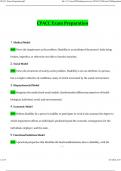CPACC Exam Preparation.pdf file:///C:/Users/HP/Desktop/eewwww/CPACC%20Exam%20Preparation
CPACC Exam Preparation
1. Medical Model
ANS Views the impairment as the problem. Disability is an attributeof the person's body being
broken, imperfect, or otherwise not able to function insociety.
2. Social Model
ANS Views the structures of society as the problem. Disability is not an attribute of a person,
but a complex collection of conditions, many of which arecreated by the social environment.
3. Biopsychosocial Model
ANS Integrates the medical and social models. Synthesizesthe different perspectives of health
biological, individual, social, and environmental.
4. Economic Model
ANS Defines disability by a person's inability to participate in work.It also assesses the degree to
which impairment affects an individual's productivityand the economic consequences for the
individual, employer, and the state.
5. Functional Solutions Model
ANS A practical perspective that identifies the functionallimitations due to disability, with the
1 of 35 8/2/2024, 4:07
,CPACC Exam Preparation.pdf file:///C:/Users/HP/Desktop/eewwww/CPACC%20Exam%20Preparation
intent to create and promote solutions to overcome them.
6. Social Identity or Cultural Affiliation Model
ANS Refers to deriving one's personalidentity from membership within a group.This model is
most evident among peoplewho are Deaf, due to their shared linguistic experience as sign
language users.
7. Charity Model
ANS Regards people with disabilities as unfortunate and in need ofassistance from the
outside, with those providing charity viewed as benevolent contributors to a needy
population.
8. Visual Disabilities
ANS Blindness, Color Blindness, Low Vision
9. Auditory Disabilities
ANS Deafness, Hard of Hearing, Central Auditory ProcessingDisorder, Deaf-Blindness
10. Speech Disabilities
ANS Articulation, Aphasia, No Speech
11. Mobility, Flexibility, and Body Structure Disabilities
ANS Manual Dexterity / FineMotor Control, Ambulation, Muscle Fatigue, Body Size or Shape
12. Cognitive Disabilities
2 of 35 8/2/2024, 4:07
,CPACC Exam Preparation.pdf file:///C:/Users/HP/Desktop/eewwww/CPACC%20Exam%20Preparation
ANS Intellectual Disabilities, Dyslexia, Dysgraphia, Math andComputation, Attention Deficit
Hyperactivity Disorder, Autism Spectrum Disorder, Non-verbal Learning Disability
13. Seizure Disabilities
ANS General Seizure Disorders, Photosensitive Epilepsy
14. Psychological / Psychiatric Disabilities
ANS Social Disabilities, Emotional Disabil-ities, Behavioral Disabilities
15. Multiple / Compound Disabilities
ANS When more than one disability is present.Describes students with the most profound
disabilities
16. Blindness
ANS Nearly complete vision loss
17. Color Blindness
ANS Inability to distinguish certain color combinations
18. Low Vision
ANS A reduced vision that cannot be corrected with regular glasses,contact lenses, medicine,
or surgery
19. Deafness
ANS The total or near-total loss of hearing
3 of 35 8/2/2024, 4:07
,CPACC Exam Preparation.pdf file:///C:/Users/HP/Desktop/eewwww/CPACC%20Exam%20Preparation
20. Hard of Hearing
ANS Hearing loss ranges from mild to severe, retaining some usefulhearing.
21. Central Auditory Processing Disorder
ANS Inability to interpret, organize, or ana-lyze what's heard
22. Deaf-blindness
ANS Includes both deafness and blindness. Most people who aredeaf-blind retain some ability
to hear and see
23. Articulation
ANS Difficulty producing specific types of sounds
24. Aphasia
ANS Impaired ability to produce or understand speech. Also affects theability to read or
write
25. No Speech
ANS Inability to speak caused by damage to the brain, speech muscles,or due to emotional or
psychological reasons
26. Manual Dexterity / Fine Motor Control
ANS Difficulty manipulating objects, writing,and dressing
4 of 35 8/2/2024, 4:07




